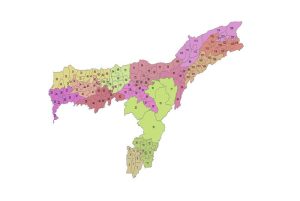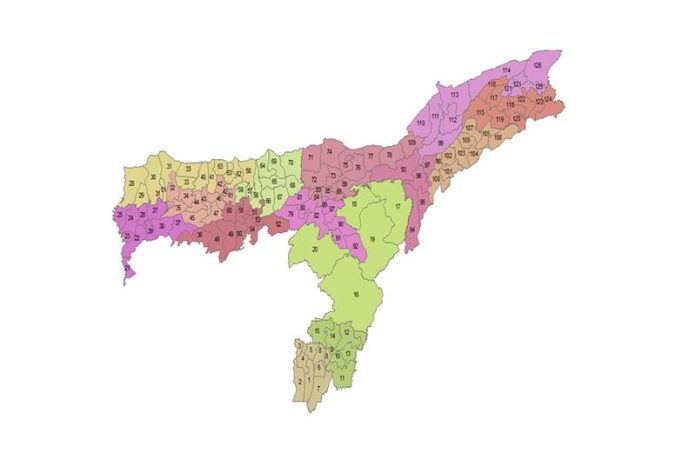Despite the matter being pending in the Supreme Court, ECI published the final order of delimitation in Assam on August 11. Chief Minister of Assam Himanta Biswa Sarma claimed that the delimitation would do what the NRC couldn’t, without going into further details. His dream appears to have come true, as President Droupadi Murmu approved the demarcation of Assam’s parliamentary and assembly constituencies on August 16. Abdul Bari Masoud analyses the situation arising in Assam after the order of delimitation was issued.

A few months ago, Chief Minister of Assam Himanta Biswa Sarma claimed that the delimitation would do what the NRC couldn’t, without going into further details. His dream appears to have come true, as President Droupadi Murmu approved the demarcation of Assam’s parliamentary and assembly constituencies on August 16. As he released the Gazette notification, Chief Minister Sarma referred to it as a “significant milestone”. The All India United Democratic Front (AIUDF), led by MP Badruddin Ajmal, said the whole process was intended to lower the representation of Muslims in the state assembly and Lok Sabha. Congress, on the other hand, claimed that the delimitation was intended to target Opposition seats in the state.
“Today the Honourable President has approved the Delimitation Notification issued by the Election Commission of India (ECI) for Assam. A significant milestone has been achieved in the history of Assam,” Sarma wrote on X.
Despite the matter being pending in the Supreme Court, ECI published the final order of delimitation in Assam on August 11. According to the new delineation, three additional Assembly seats have been set aside for Scheduled Tribes (STs), while one additional seat has been set up for Scheduled Castes (SCs). The panel also changed the names of at least 19 Assembly constituencies in the final order. The overall number of Assembly seats remained at 126, and the number of Lok Sabha seats at 14.
However, accusations of partiality for the state’s ruling BJP have dogged the entire process from the very beginning. The EC was criticised by the Opposition parties in Assam for serving as “an extended arm of the BJP” in a “conspiracy to safeguard” the saffron party’s support base.
The EC had consultations with a variety of stakeholders, which included pre-meetings prior to the report’s preparation in March 2023 and three days of public hearings in Guwahati on the draft proposal in July 2023.
However, it is alleged that the poll panel drafted the final notification without properly consulting all parties. Before presenting the draft proposal, a delegation from the ECI led by CEC Rajiv Kumar visited Assam between March 26 and 28 and spoke with 11 political parties and 71 other organisations. Despite invitations, the Opposition Congress chose to boycott the meeting with the ECI. Debabrata Saikia, a prominent Congress lawmaker and head of the Opposition in the Assembly, claimed that the draft proposal was prepared at the BJP’s behest.
Congress leader and MP Gaurav Gogoi reacted to the final report, saying, “If you look at the Assam delimitation, it is targeting the opposition seats. The BJP has focused particularly on the Lok Sabha seats held by the Congress party in Kaliabor, Nagaon, and Barpeta. The AIUDF has gained. Thus, it reveals the relationship between the BJP and the AIUDF. However, the BJP is erring if they believe that the redrawn boundaries of Assam will benefit them in the forthcoming Lok Sabha elections. The INDIA alliance is in the air…The INDIA coalition and Congress party will perform particularly well in the 2024 elections in India and Assam.”
Slamming the EC, Gogoi, son of former chief minister Tarun Gogoi, said that even though the Supreme Court is now reviewing the delimitation of Assam, the Election Commission decided to publish the delimitation list before waiting for the court to issue its ruling.
He underlined: “The delimitation of Assam is currently being reviewed by the Supreme Court. The Election Commission has decided not to wait for the Supreme Court to give its final order and has gone ahead with publishing the delimitation list. If you see this in conjunction with the Bill that was recently introduced in Parliament where the CJI has been removed from the selection panel of Election Commissioners, it shows that the BJP does not want the CJI and Supreme Court to have a role in an unbiased Election Commission.”
However, I don’t believe this will have any influence on the results of the 2024 elections because, generally, support for the INDIA coalition is growing, a Congress MP asserted.
Assam Congress President Bhupen Kumar Borah also questioned the poll body for hurriedly publishing the draft when the matter is pending in the Supreme Court.
According to Borah, the state Congress never expressed a principled objection to the delimitation process, but on January 1 this year, it met with EC officials in Delhi and sought explanation on a number of issues.
Even Asom Gana Parishad, which is a partner in the Assam government, vented its ire against the final report. AGP leader Prodip Hazarika said he vehemently rejected the final report, which would have erased his constituency of Amguri in Upper Assam. “This is totally unacceptable. When the EC members visit Assam the following month, we will protest this action,” he said.
Before the final draft was published, Akhil Gogoi, Raijor Dal MLA, also criticised the draft text and claimed that the “BJP’s idea” was the basis for its creation. “To meet the needs of the BJP, the delimitation was done by changing the demographics of the constituencies. The draft reports from the EC and the Saffron Party are nearly identical. He alleged that the additional ST seats would give Bengali Hindus space instead of the native population.
On the same line, Lurinjyoti Gogoi, head of the Assam Jatiya Parishad (AJP), said it is “very unfortunate and conspiratory,” as the party had previously informed the EC that delineating Assam’s indigenous communities based on the 2001 census “will finish them”.
Meanwhile, AIUDF leader Badruddin Ajmal also angrily responded to the report, claiming that the aim of the effort is to lower the percentage of Muslim voters in both Lok Sabha and Assembly constituencies.
“In Assam, Muslim voters account for almost 35 per cent of total voters and play a decisive role in more than 55 assembly and seven Lok Sabha seats. After Jammu and Kashmir, Muslims are heavily concentrated in this northeastern state. Because of their formidable numbers, they are constantly targeted under one pretext or another. They have been dubbed Bangladeshi infiltrators.” After the NRC exercise was carried out in 2015, the Bangladeshi infiltrators’ bogies were smashed, as was referred to by the Assam CM in his above statement.
Maulana Ajmal is the lone Lok Sabha member of the AIUDF representing Dhubri, and it currently has 15 MLAs. The AIUDF joined electoral politics in Assam in 2005, with Muslims as its core vote bank.
In a conversation with Radiance, Maulana Ajmal claimed the draft plan was made under the direction of Assam CM Sarma and Union Home Minister Amit Shah in an effort to “remove AIUDF from Assam politics.”
Scoffing off Congress leader Gaurav Gogoi charge that Delimitation exercise “exposes the nexus between AIUDF and BJP”, he said it will do a lot of harm to us (AIUDF). This will help the Congress in at least 10 to 12 Assembly seats. They want the politics in Assam to be a fight just between Congress and BJP.
AIUDF was singled out by BJP during the Assembly elections as “a party of the illegal migrant from Bangladeshis.” On the other side, the saffron party attempted to present itself as a party promoting the rights of the indigenous people and defending their identity from Ajmal and the illegal immigrants’ threats.
Earlier he told news channels in Guwahati that the BJP is attempting to banish AIUDF from Assam politics with this scheme. This is being done on purpose. This is being done in an effort to cut as many Muslim votes from the total as possible. We felt that there was no need for such an action right now in Assam alone because delimitation would take place across the entire nation after 2026. “The motive is negative. This is being done in accordance with BJP plans and to achieve BJP objectives,” Ajmal said.
AIUDF organisational general secretary and MLA Aminul Islam said the last delimitation in Assam took place in 1976 on the basis of the 1971 census.
“Now it’s 2023, and the delimitation is taking place on the basis of the 2001 census. It means a gap of more than 20 years. Why not take the 2011 census? Why is this exercise being done midterm?”
In 2026, delimitation will happen across the country. The assembly and parliamentary constituencies will increase. Why not do it then? If it does not take place in 2026, Assam will be deprived of getting more seats, the AIUDF MLA underlined.
Aminul Islam also claimed that the draft proposal contains several paradoxes because there is no explanation provided for the increase in SC and ST seats.
Political considerations drove the seat modifications. Major changes have not occurred in Upper Assam. Where there is a sizable Muslim population in Lower and Middle Assam, the majority of the alterations have been made. The main effort has been to lessen the number of seats with Muslim majority, Aminul Islam said.
As expected, there were demonstrations across the state against the delimitation report’s final draft due to the non-reservation of the Morigaon Assembly constituency, the rejection of the demand for the Lahowal and Amguri Assembly constituencies in Sivasagar district to remain intact, and the inclusion of Sivasagar district areas under neighbouring districts.
A new delimitation exercise was supposed to be carried out in 2007, but was postponed due to law and order issues. The ECI, however, resumed the process for the exercise in December last year after being asked by the Assam government.




